St. Augustine is the oldest town in the United States and is located in the northern part of Florida not too far from Jacksonville. It was founded in 1565 by the Spanish admiral and the first governor of Florida, Pedro Menéndez de Avilés, who named it San Agustín. The city itself is not big but you can easily spend a full day here. There is plenty to see and it can all be done by foot. It’s a bit touristy but it’s still very nice and definitely worth a visit if you’re in the area or if you are up for seeing an old historic American town.
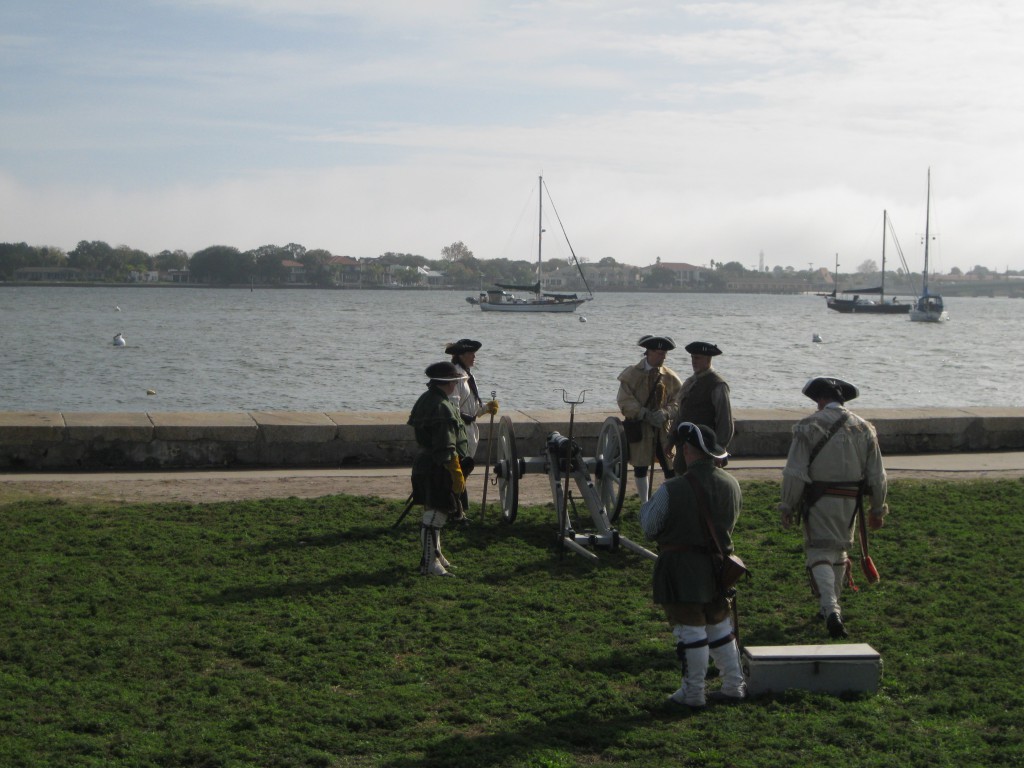
The best thing about St. Augustine is without a doubt the fort Castillo de San Marcos located at 1 S Castillo Drive. This fort was initially built to guard the Spanish colonies against enemies. You can easily spend between 2-3 hours here checking out the well preserved beautiful architecture and history of the structure. Just outside the fort there will be demonstrations on how soldiers operated muskets and cannons back in the day. This is done by employees dressed up as British redcoats and the demonstration is on every hour during the day. You can start by walking around the fort checking out the structure, the corner towers and the way it has kind of a star shape with four corners for four bastions. You can get all sorts of cool photos from many different angles.
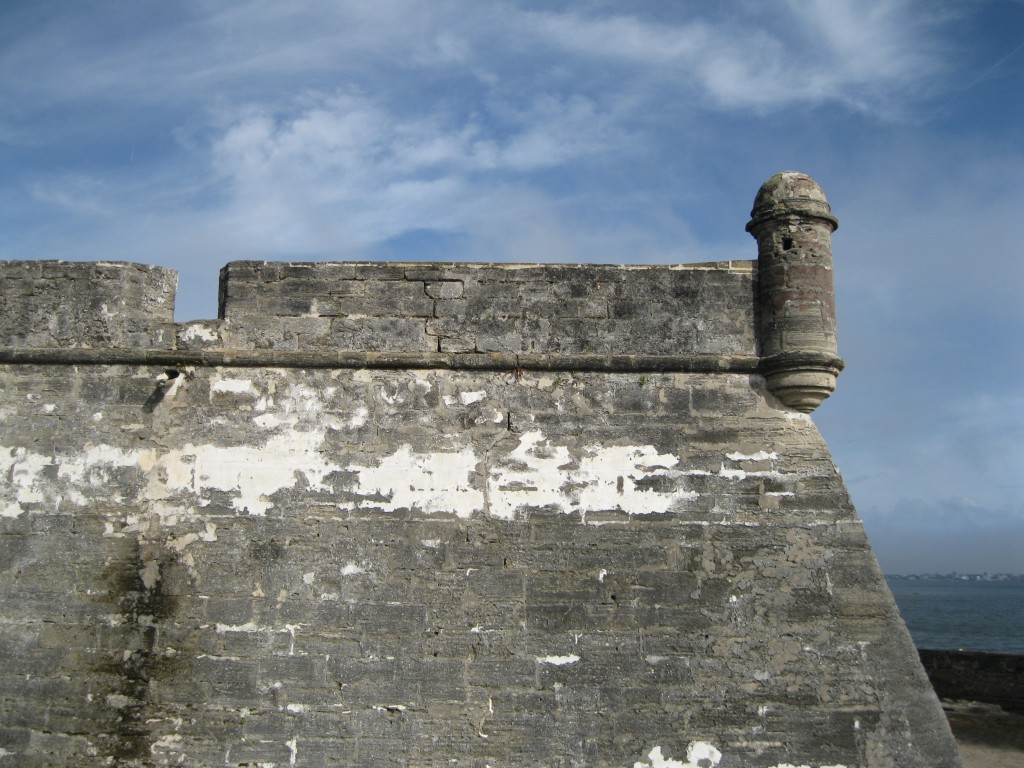
It’s now known as the Castillo de San Marcos National Monument and is the oldest masonry fortification in the continental United States. It replaced the last of nine wooden forts which, since 1565, had affirmed the Spanish domination and protected Spanish ships returning to the homeland. The fort was designed by Spanish engineer Ignacio Daza, the construction began in 1672 and was finished in 1695. European countries fought for the control of the New World. France, England and Holland would attack Spain’s territories in the Americas so St. Augustine was established in a series of fortified towns to defend Spanish shipping. Spain lost Florida to Great Britain in 1763 after a seven year long war. Most Spanish families moved to Cuba. East and West Florida became the 14th and 15th colony of Great Britain and unlike the colonies in the north they remain loyal to King George after the declaration of independence. In 1784 Spain regained Florida after helping the United States defeat Great Britain during the American Revolution. Some of the old Spanish Florida families returned. Border conflicts increased and the United States pressurised Spain to sell Florida and it was acquired by the United States in 1821 for 5 million USD. Both Federal and Confederate troops would serve at the fort during the Civil War. In the 1870s, Kiowa, Cheyenne, Comanche, Apache and Caddo Indians were imprisoned at the fort. During the Spanish-American War in 1898 it was used as an army supply depot. The army left in 1900 and it was no longer used. President Coolidge made the fort a national monument in 1924.
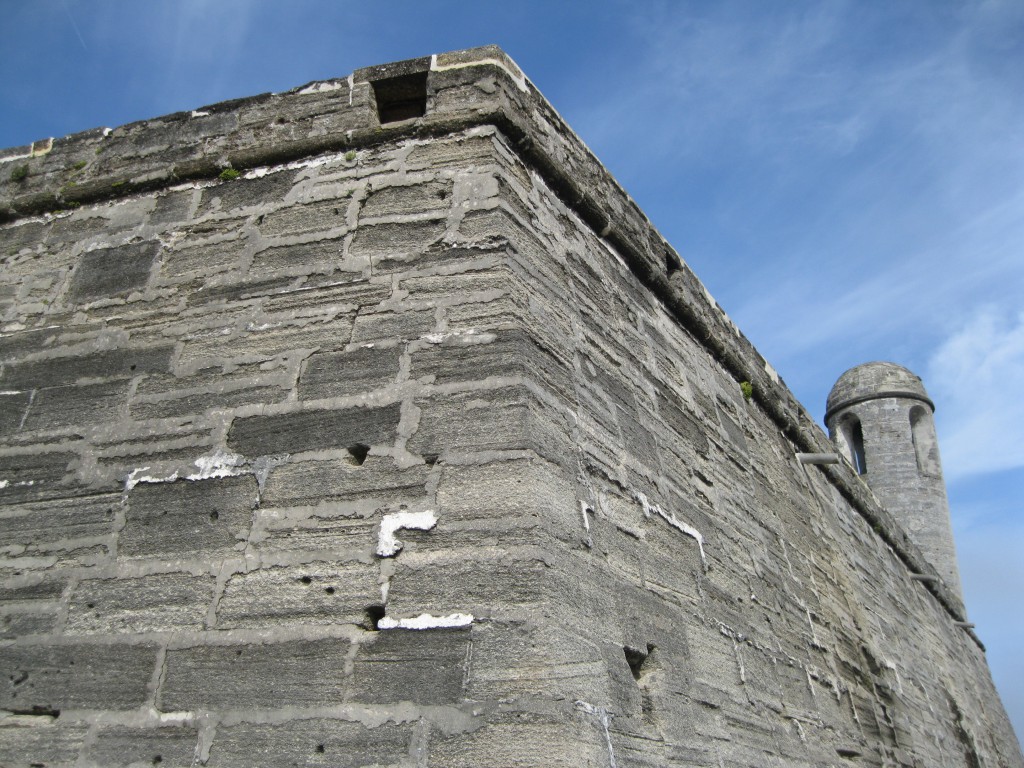
It is highly recommended that you purchase a ticket to visit the inside of the fort. Get a free brochure at the entrance and do a tour of the castle. If you are up for it you can have a chat with the rangers as well. The structure has several rooms, a yard which is called the Plaza de Armas and an upper level with four different bastions in each corner of the structure. In some of the rooms there are different examples of carvings of a fleet of ships which most likely were done by Spanish soldiers. They would be more familiar with the design of a ship than we would be with our car or bike in present day. At the time St. Augustine was a remote colony and the only form of transportation and possibility for bringing food, supplies and news was by ship. The United States first occupied the fort in 1821 and the US soldiers added American flags to the carvings of Spanish and British ships. Some of the carvings are also of British ships which can be determined by the checkered pattern which they used on their ships around 1800. This design was made popular by Admiral Horatio Nelson and is known as the Nelson Checker. The British took over the fort on 21 July 1763 by treaty after 198 years of Spanish rule. The Spanish would get Florida back 21 years later by another treaty for 37 more years until it became a part of the United States in 1821.

On the top level of the fort you are able to walk around and check out the cannons and enter some of the corner towers. When investigating closely you can clearly see that the structure is made out of shellfish rock which is sedimentary rock known as coquina. It has a similar strength to limestone.
The city of St. Augustine itself has a lot of interesting old architecture on display. The Cathedral of St. Augustine is a great piece of Spanish design from 1797. The Parish of St. Augustine is the oldest Catholic parish within the present day United States and dates back to 8 September 1565. If you are up for it you can have a look inside as well.
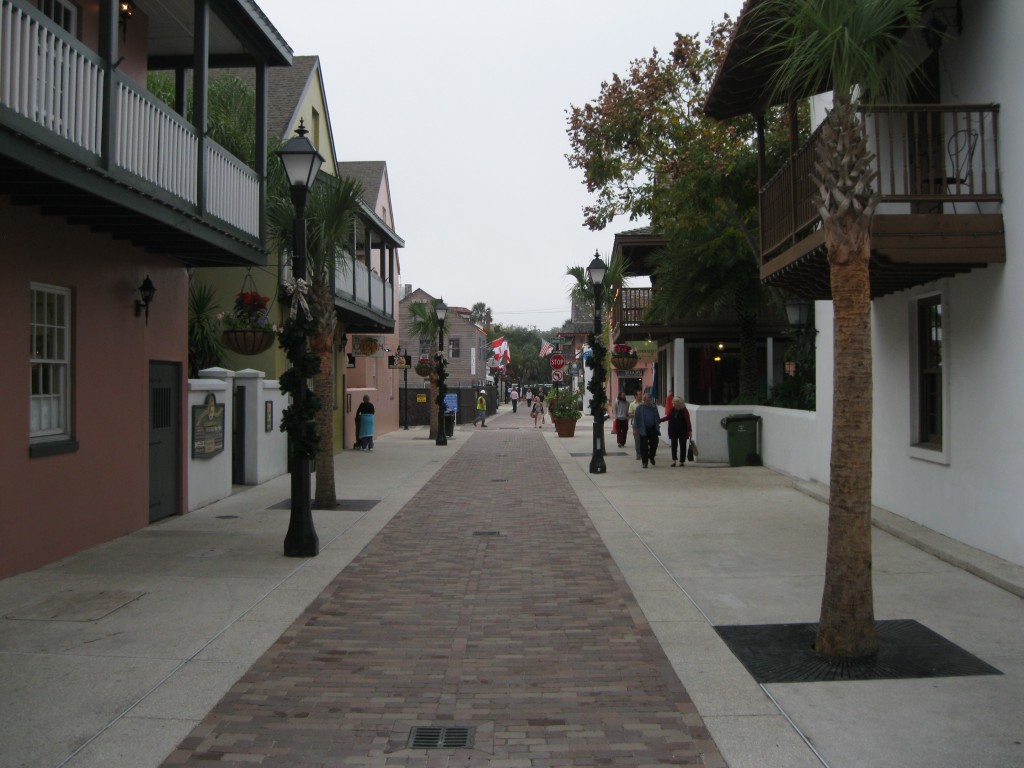
George Street is the main shopping mall which is a bit touristy. Still when you are in town checking it out is an absolute must as you will find some nice old architecture in this area. Furthermore it is in the heart of the city with a lot of souvenir shops, restaurant and galleries. At 14 George Street “The Oldest Wood School House in the USA, St. Augustine, Florida” is based. Pretty cool and if you’re up for it you can have a look inside for an admission fee. The exact date of the construction is not known but it appeared on tax records for the first time in 1716. There are no wooden buildings in town dating earlier than 1702 which is when the British burnt down the city. The walls are constructed of bald cypress and red cedar wood, put together with wooden pegs and handmade nails. The schoolmaster and his wife lived upstairs in the day. Related artefacts and copies of books used by the pupils are on display. Even though it’s promoted as the oldest wooden school in the United States, that is not the case. In the neighbourbood of the historic Richmond Town on Staten Island, New York, the Voorlezer’s House is located which is most likely the oldest wooden school dating back to around 1695.
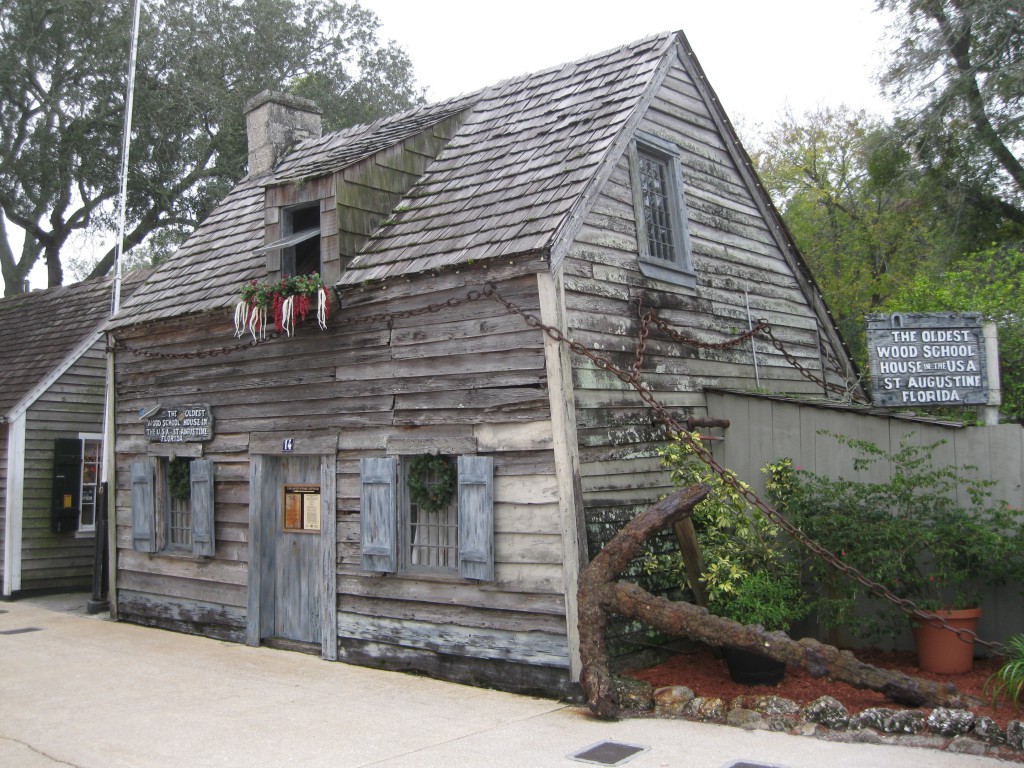
Flagler College is located at 74 King Street and is a private liberal arts college. The centre piece is the Ponce de Leon Hall which was built as a luxury hotel in 1888. It was designed by John Carrere and Thomas Hastings who were contracted by Henry Flagler who was an industrialist, oil businessman and railroad pioneer.
If you walk around in the neighbourhood of George Street you will find a lot of cool buildings and architecture in areas where it is more peaceful and less crowded. For instance if you stroll down to Cordova Street you will see Thompson Hall among other historic buildings. At 8 Carrera Street the Grace United Methodist Church is located which is pretty cool, designed in the style of Spanish Renaissance in coquina. Henry Flagler was instrumental in having it constructed between 1886 and 1887.
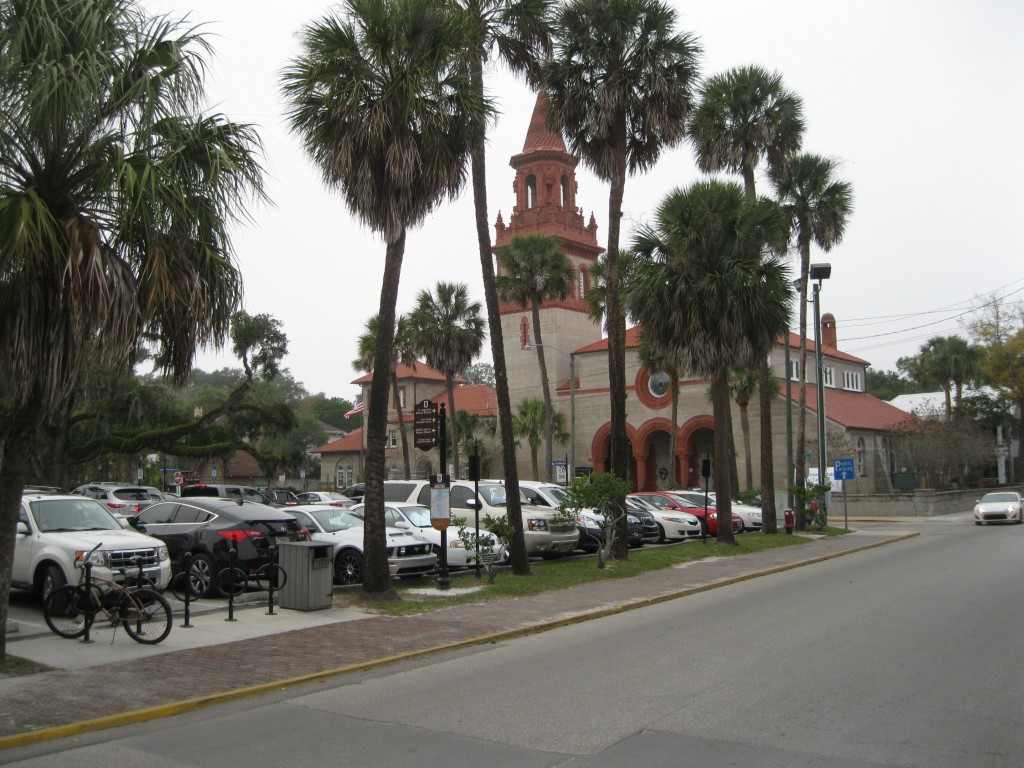
At 70 Hypolita Street a restaurant called Scarlett O’Hara’s is located in a historic wooden building on the corner of Cordova and Hypolita. It’s made up of two 1879 homes, built by a Mr Colee, one for his true love and one for a retired lighthouse keeper. The family lived in the two storey house until 1955. In 1979 it was sold to an entrepreneur who turned it into a bar and restaurant which was ideal as it is close to Flagler College.
Carriage Way at 70 Cuna Street is another great example of Victorian architecture. It was constructed between 1883 and 1885 by Edward and Rosalie Masters for their family. Edward Masters was a lead carpenter for Henry Flagler and worked on many of his projects such as the Ponce de Leon Hotel. In the 1940s it was converted into apartments and was restored in 1984.
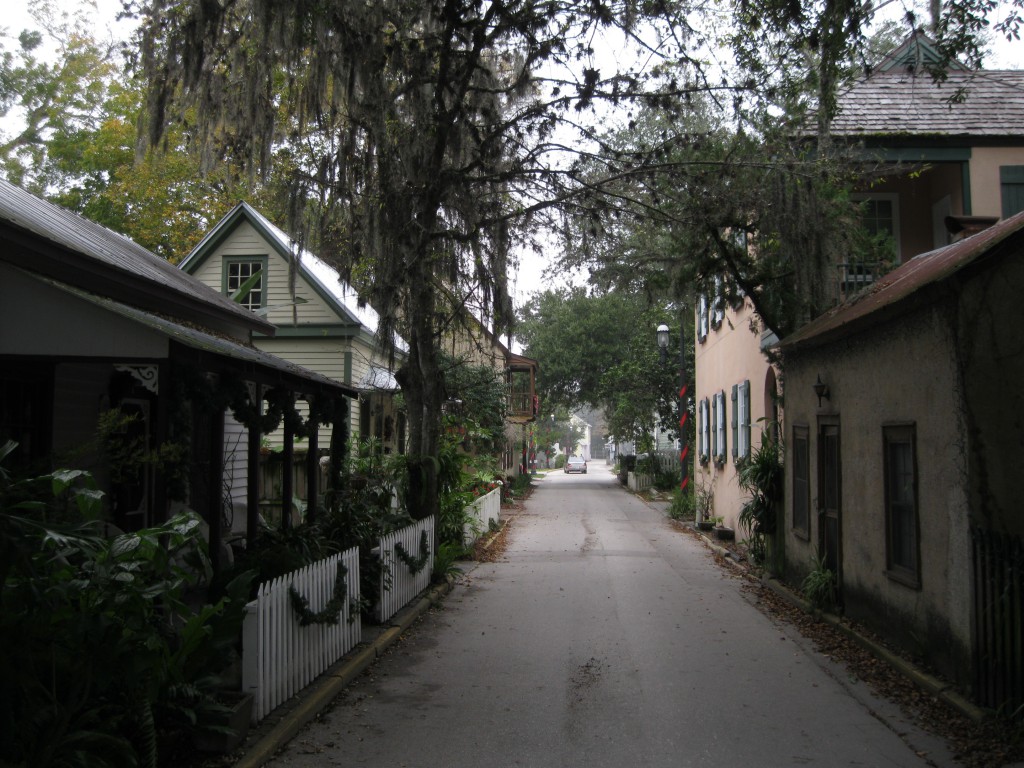
Henry Flagler brought the railroad to St. Augustine in the late 1880s. He had several grand hotels which attracted a lot of wealthy visitors for the winter. In 1821 Florida became a territory of the United States and prior to that there had been an international border between Georgia and Florida. Therefore Americans had not really explored Florida and were curious about the exotic plants and animals as it was like the last frontier on the East Coast. Tourists began venturing into what at the time was the only established city on the peninsula which was St. Augustine. It wasn’t that easy to get there at the time but it was done by steamboat from either Charleston or Savannah via the St. John’s River to Picolata. Here they would be picked up by the stagecoach which would consist of a four horse coach, carriages and light wagons, then travel a distance of about 29 km (18 miles) which took about 8 hours, where they would encounter bumpy and muddy roads and maybe Indians on the way so they would need an escort. Initially tourism overwhelmed the hotels of the town, so the period of the boarding houses began. A lot of the tourists came from the north and were used to a certain standard of living. A boarding house and a hotel were two completely different things, the former being a comfortable style of accommodation where the visitor would stay for 3-5 months and would therefore have more of private home atmosphere.
On 20 Aviles Street the Ximenez-Fatio House is located which is pretty neat. It was built for Andres Ximenez around 1798 who was a merchant. In 1823 Margaret Cook bought the property and ran it with Eliza Whitehurst as a boarding house called “Mrs. Whitehurst’s”. After Whitehurst died, Cook sold the house to Sarah Petty Anderson in 1838 who had come from the Dunlawton Plantation which had been burnt down during the 2nd Seminole War in 1836. Anderson hired Louisa Fatio in 1851 to manage it as a boarding house, who was also a refugee from her plantation which had suffered the same fate as Dunlawton. She then bought the property four years later and ran it as a fashionable inn for twenty years.

An interesting aspect about the history of this property is that in the day of territorial Florida, women didn’t have the same legal rights as they have today. Back then women would stay at home and their husbands would own the properties, however if they were widows they were allowed to own property and operate a business. This was one of the few businesses in which women could excel at, having a lot of domestic skills which they could turn to commercial advantage. They really set the stage for tourism in St. Augustine.
In 1939 the Ximenez-Fatio House was bought by the National Society of Colonial Dames of America who turned it into a museum. The house is very intact, has been restored to what it was back then and they are very focused on keeping it authentic. It was built with coquina stone which was the material close at hand. It’s considered the best preserved Spanish colonial dwelling in St. Augustine.
Back in the day there was no plumbing, no running water or toilets so every room would have a chamber pot. There was no electricity or air conditioning either so they would have to use oil lamps or candles and open windows during the hot periods or use the fireplace when it was cold. People visiting the boarding house were from all walks of life such as families from the north, military officers, ship captains or naturalists who would paint pictures of the local plant and animal life for people up north to see. Doctors in the north would also send patients down south to St. Augustine as they thought the climate had restorative powers. The boarding house served three meals a day and gained quite a good reputation based on the quality. The guests would use their free time by walking around town, visiting the fort, going to the beach or reading the newpaper. Yet another interesting aspect is that the dames who bought the house did it at the height at the depression in the 1930s. It must have taken a lot of guts to buy a rundown house which had to be restored.
In the area of Aviles Street there are other cool wooden buildings as well such as the the Victorian House at 11 Cadiz Street which as the name suggests is a Victorian building. It’s said to be on the corner of the oldest street in town, was built in 1895 and was restored in 1983. On Aviles Street you will see a lot of nice historic buildings, small cosy cafés and restaurants.
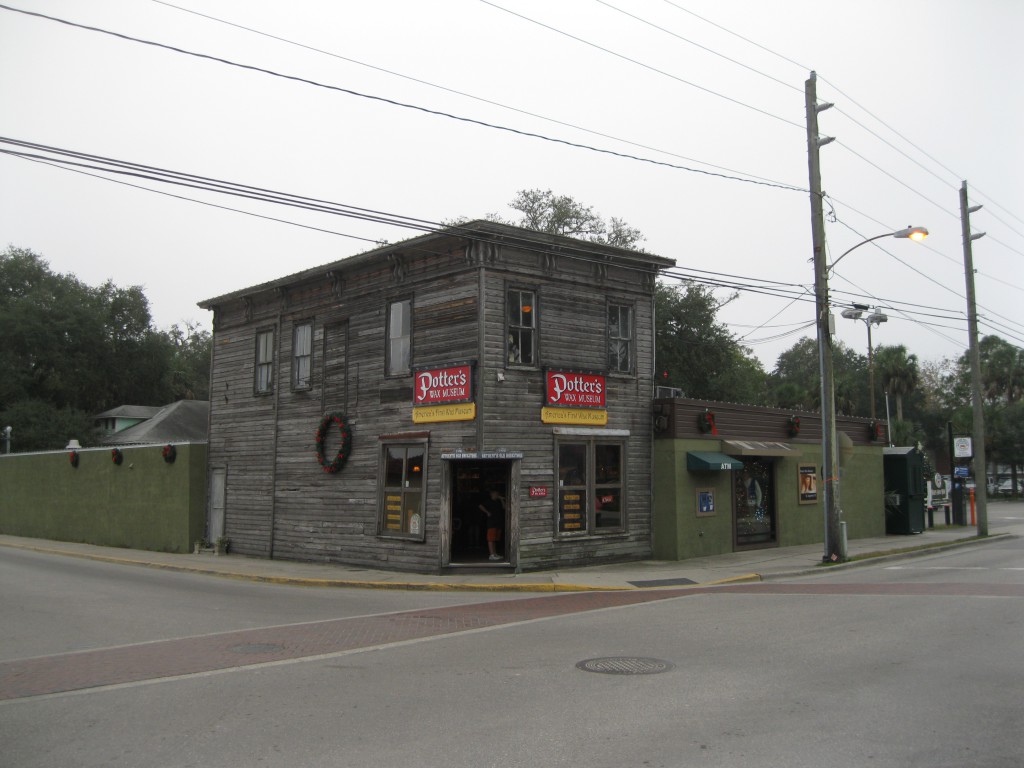
Another highlight is the “Authentic Old Drugstore” located at 31 Orange Street. It was built in 1739 by Antonio Gomaas outside the jurisdiction of of the city. Liquor, tobacco, medicine and Indian remedies were sold. This was back in the day when St. Augustine was just a small Spanish settlement. The building was bought by pharmacist T.W. Speissegger off a Gomaas descendant who in 1880 moved the building to Bay Street and later to Orange Street in 1887.
